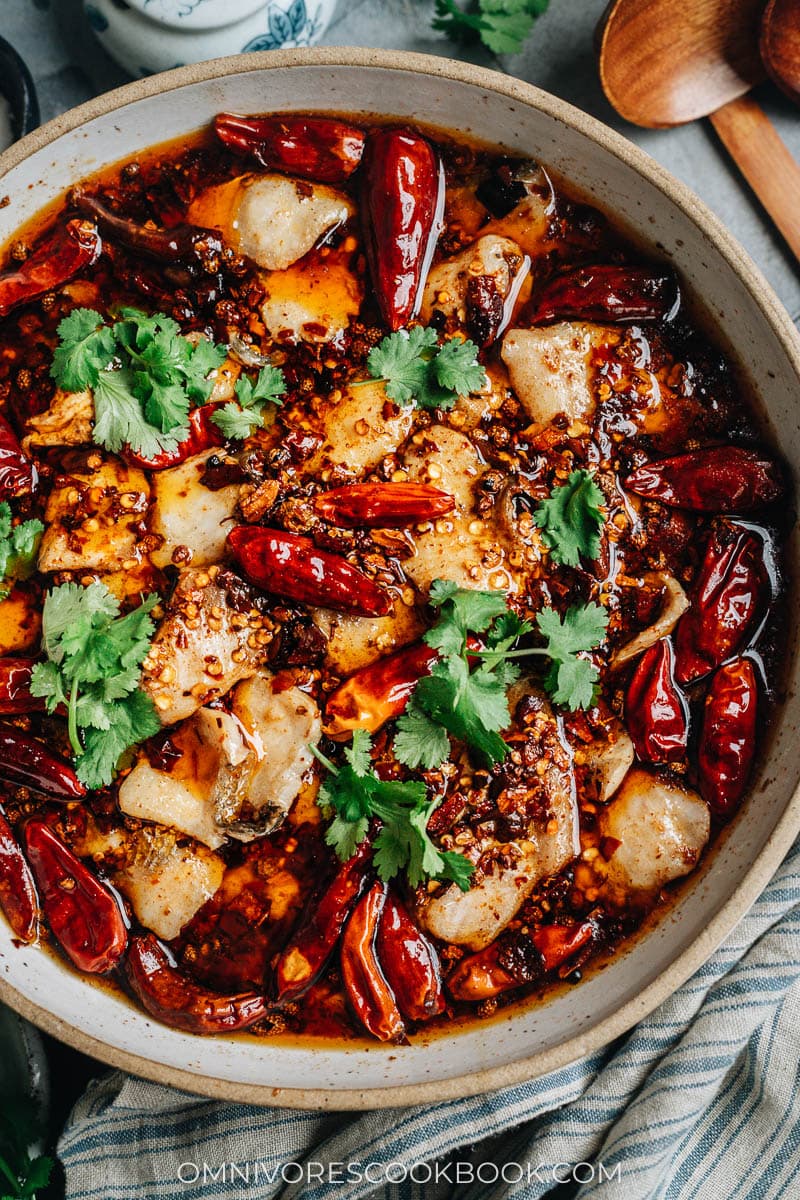
There are a few dishes I’ve truly missed after moving from China to the US. Shui Zhu Yu, or Sichuan boiled fish, is one of them. Not only is this dish addictively tasty, but it also represents friendship, gathering, and celebration. It’s one of those must-have dishes when I hang out with friends and family when we want something slightly fancy. I remember when a friend of mine came back from Japan, we went all out by ordering boiled whole fish, dan dan noodles, chicken in red oil, and stir fried pea shoots. It was just two of us girls and we finished it all. And she kept telling me how much she missed the food. Now I can relate.
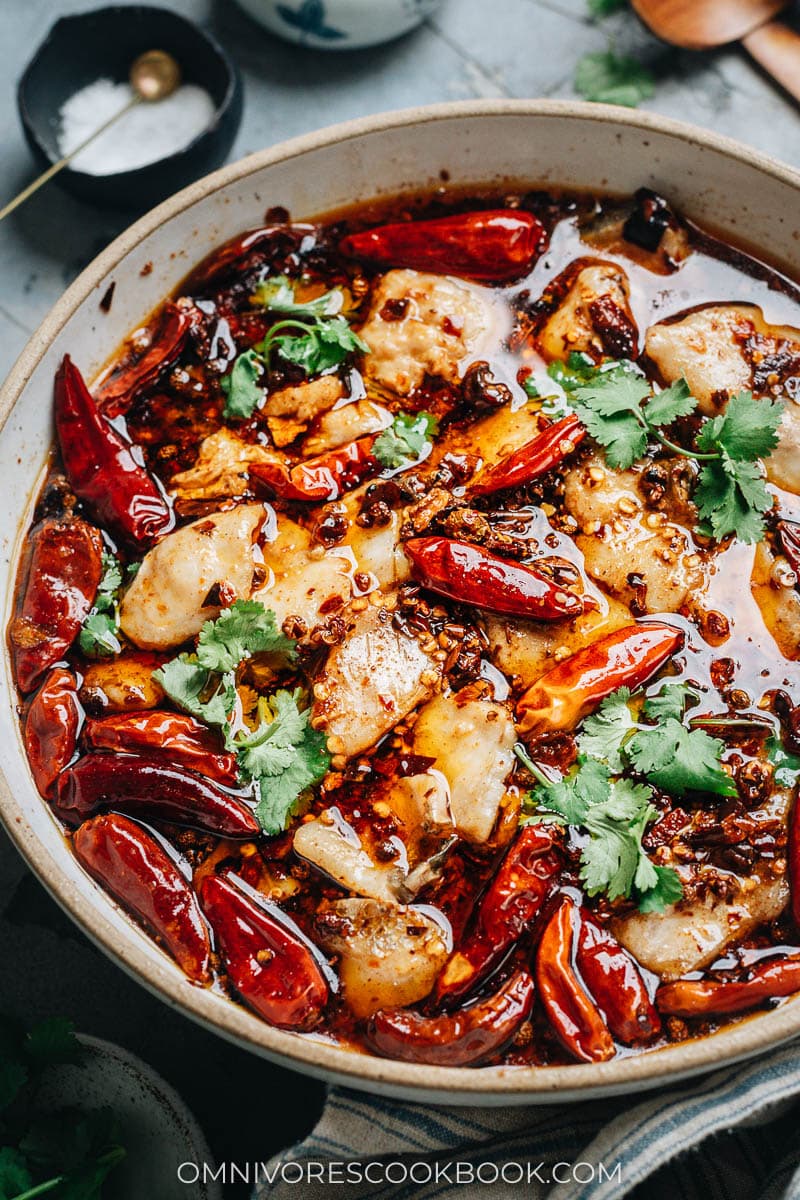
What is Shui Zhu Yu
Shui Zhu Yu, translated literally, means “water boiled fish”, which sounds bland and does not represent the dish at all. The dish is the opposite of the typical idea of “boiled” you might have in mind.
It uses bowls of dried chili peppers, Sichuan peppercorn, and doubanjiang to create a rich, savory, spicy, and intense aromatic broth. The fish is very thinly sliced, marinated, and cooked briefly in the broth until tender and juicy. It is then finished up by pouring hot oil over the fish and the broth. The boiling oil will further cook the spices to release more fragrance. Every bite of fish will be thinly coated with the sauce and fragrant oil, giving it the most satisfying sensation.
The dish is usually served in a giant bowl with a bed of vegetables hidden under the fish. The veggies are so nicely seasoned that they’re just as good as the fish.
At the restaurant, you can choose either the cheapest fish – carp – or a fancier fish such as catfish, bass, or snapper, but they’re all live fish. Once you pick a fish, the chef will bring the fish in a net to show you that it’s alive, before it heads to the kitchen.
Making Shui Zhu Yu at home
Before moving out of China, Shui Zhu Yu was one of the dishes I never would have imagined cooking at home. But after many disappointing renditions of it at restaurants in the US, even at some of my favorite Sichuan restaurants, I decided it was time to develop a recipe. The dish is not a cheap one in China, and it’s even more expensive in the US. Here the portions are usually small, the fish not as fresh, and the spices not as fierce.
Once I started looking into the recipe, I surprisingly found that it’s actually very possible to recreate the restaurant version from back in China.
This is by no means an easy recipe. But if you’re a serious cook and would like to get your hands on the very authentic Sichuan dish, this is the one for you.
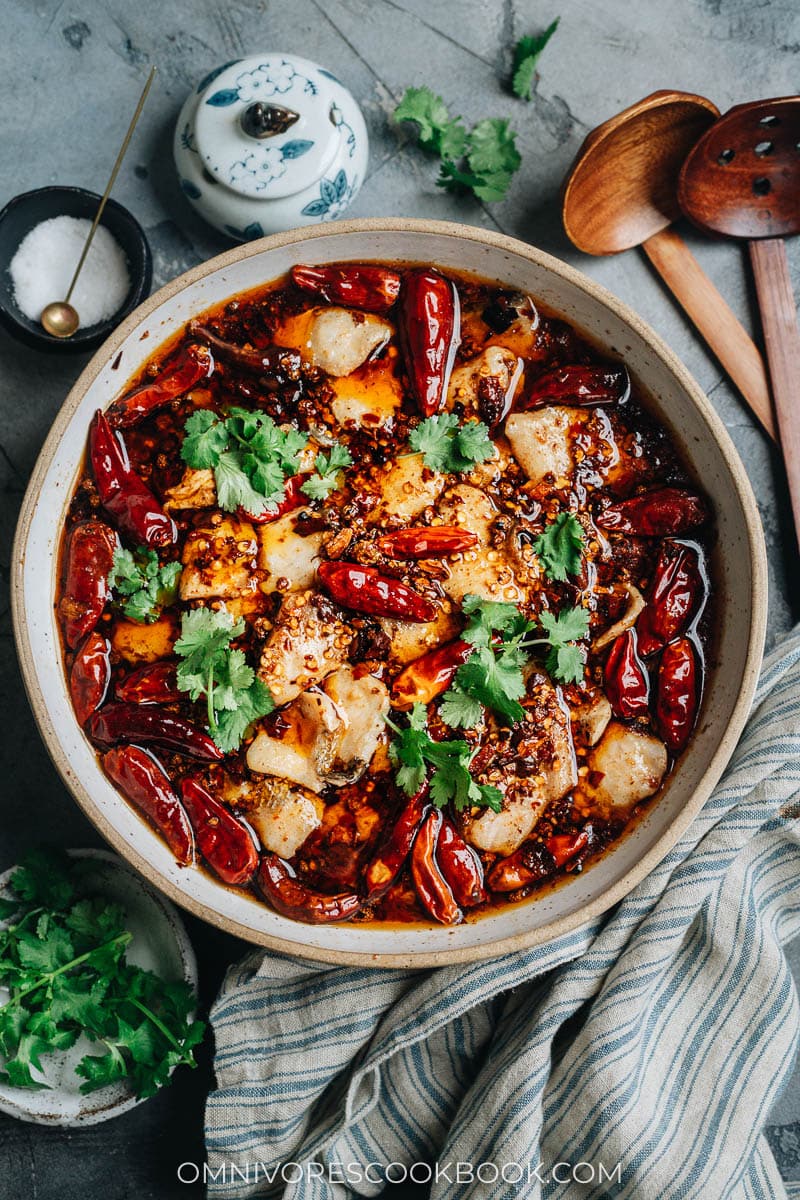
The ingredients & spices
Whole fish vs. fish fillet
For me, you have to use a very fresh (live if possible) whole fish to make the dish, otherwise it won’t be quite right. When using a fresh whole fish, you can slice the fillets extra thin without them falling apart after cooking. Because the fish flesh will be slightly firmer and the fish skin will hold the pieces together. And it will taste richer. The fish will also have a slightly springy texture that a frozen piece of fish no longer has.
When you use a whole fish, you will use the fish bones and fish head in the broth, further adding layers of flavor to the dish.
All that said, you can totally use frozen fillets in the recipe below, if a whole fish is nowhere to be found. We’ve developed the recipe in a way that you will end up with a great meal no matter what cut of fish you use.
What fish to use
Many types of white fish will work in this dish, but I personally prefer a slightly oily fish for a more satisfying texture. Back in China, my favorite fish to order was catfish. Because it is affordable and has very rich flesh. However, it’s hard to find a smaller sized catfish in the US. We ended up using branzino and I was very happy with the result. Alternatively, you can also use sea bass, snapper, flounder, and other types of white fish, as long as it has a firm texture. Avoid cod because it will fall apart during cooking.
Doubanjiang
Doubanjiang, or fermented spicy broad bean paste, is the foundation of the dish and adds saltiness and fermented umami. It’s the key ingredient in many Sichuan dishes such as mapo tofu and twice cooked pork. You should have this one in your pantry if you love Sichuan food.
You can easily get it at Asian markets or on Amazon.
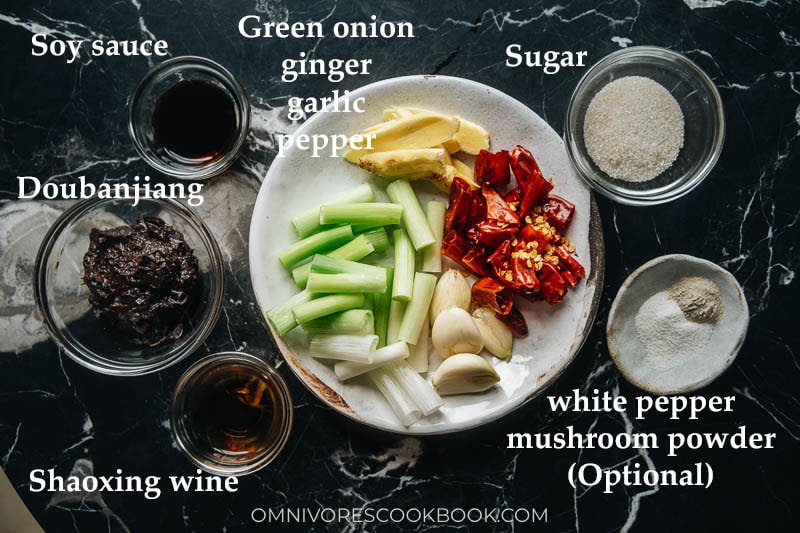
Chinese chili peppers
Authentic Shui Zhu Yu uses tons of dried chili peppers, to add aroma, spiciness, and the stunning appearance (In China, you will find the bowl contains more chili pepper than fish). The type of dried chilis used here are not super spicy, so the dish won’t taste intolerably hot.
You can find some of the best peppers at The Mala Market. I like to use a combination of Facing Heaven Peppers and Lantern Peppers. Both are medium spicy, and the latter imparts a nice smokiness to the dish.
If you cannot find Chinese chili peppers, the Korean chili peppers will work as well, since they have a similar spice level.
Avoid Thai bird’s eye chili peppers because they are too spicy.
Sichuan peppercorns – red and green peppers
Sichuan peppercorns are the main ingredient in this dish to create that numbing tingling sensation. Authentic Shui Zhu Yu uses both the red and green peppercorns. Both have slightly different tones – one is a bit warmer and the other is grassier.
Because they lose potency quite fast and the fresh ones make such a difference, you should use the highest quality product you can find. I highly recommend the red Sichuan peppers and green Sichuan peppers from The Mala Market.
If you have green pepper oil, you can skip the green peppercorn and drizzle 1 teaspoon at the end of cooking to further boost the dish.
On the other hand, if you do not have the green peppers, you can skip it and use the red ones instead.
One word on mushroom powder
Since most Chinese restaurants will use MSG in the dish, we decided to add mushroom powder (or you can use chicken bouillon powder) to give the dish an extra kick so it’s astonishingly close to the restaurant version. You can totally skip it as well.
Cooking process
Butcher the fish
As I mentioned above, it’s best to use a whole fish. And here is how to butcher it.
But you can skip this step as well, if you plan to use fish fillets.
- Work on one side at a time. Slice along the spine of the fish. Slice along the collarbone and the tail.
- Cut against the bone to slice off the flesh.
- Examine the fillet and remove any leftover bones. Then work on the other side.
- Chop the fish bones into a few pieces for the broth.
- Angle the knife to make thin slices. Note, if you’re using a frozen fillet, you will need to keep the slices thicker so they won’t fall apart during cooking.
- Marinate the fish including the bones and the head. You will use them to cook the broth.
The advantage of using a whole fish is that you can use the bones and the head to create an extra rich broth.
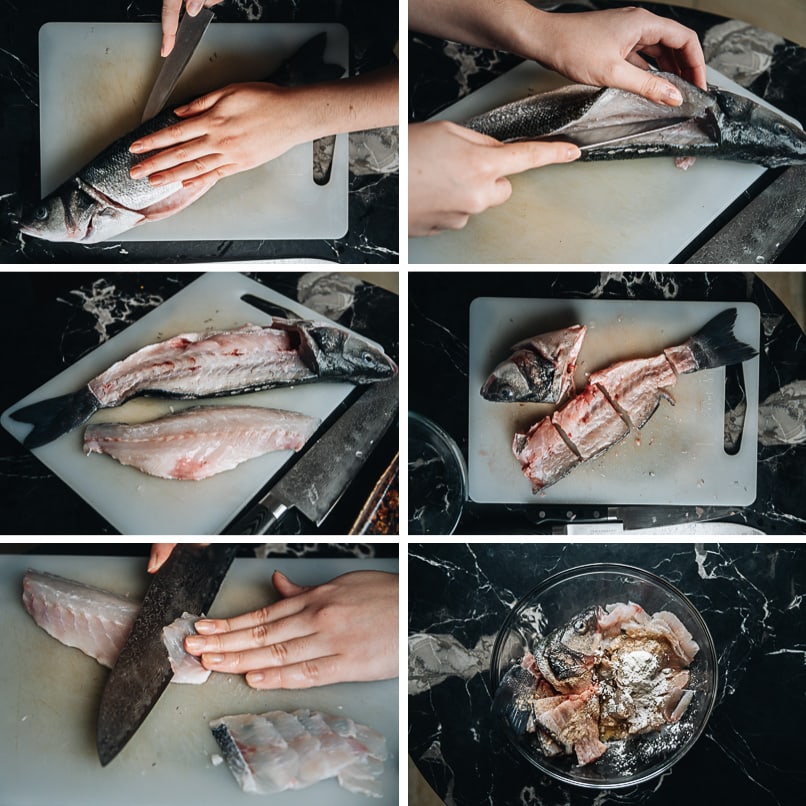
Prepare the topping
- Cut the dried chili peppers in half
- Pan fry the chili peppers and Sichuan peppercorns in oil to release their fragrance
- Once cooked, let them cool a bit
- Grind the chili peppers into coarse pieces for the topping
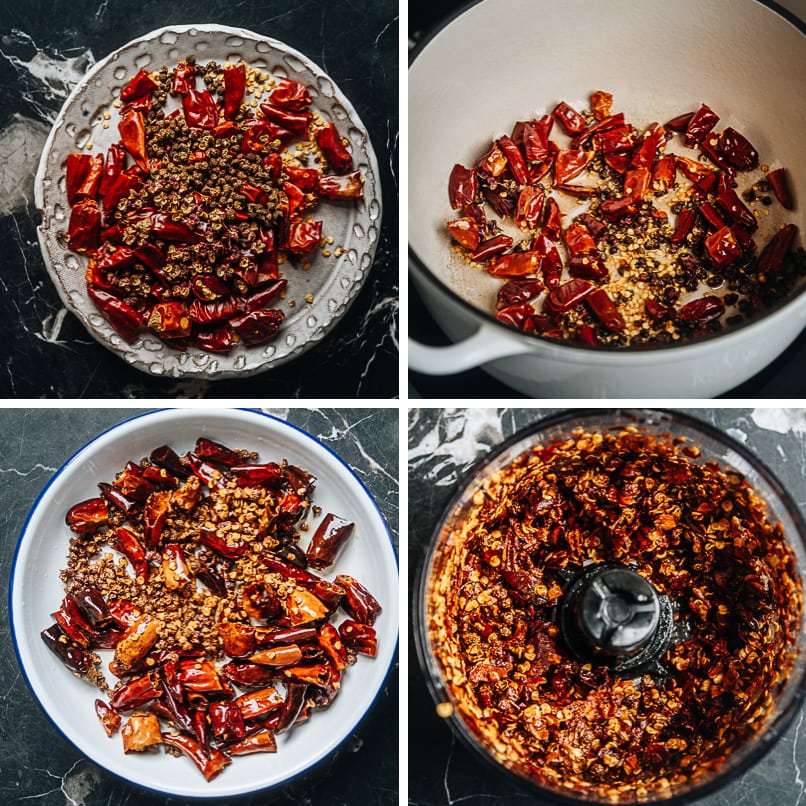
Note
In China, most of the time chefs use cups of cut-up dried peppers for the topping. Here, since high quality peppers are more expensive and rare, I grind the peppers into smaller pieces so you don’t need a ton of them to add a ton of flavor. At the end of the cooking, you can throw in some whole chili peppers for appearance if needed.
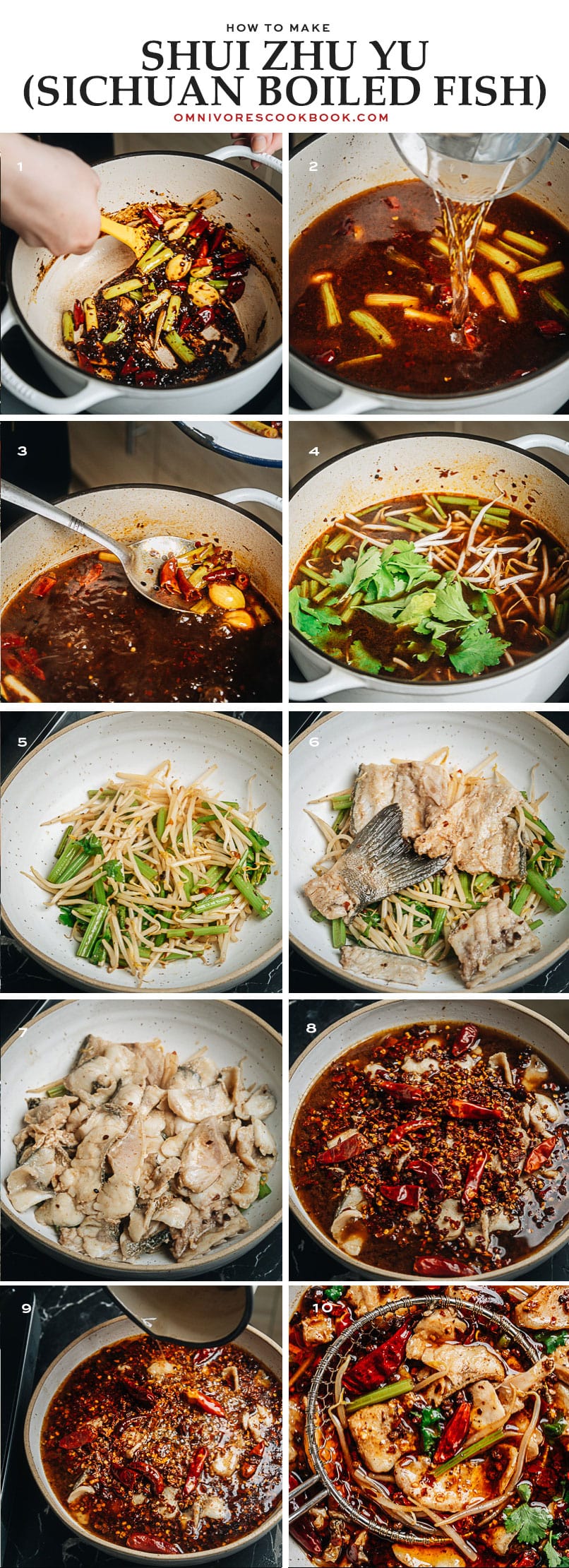
Cook the dish
- Pan fry all the aromatics and the doubanjiang
- Add water and bring to a boil. Let simmer for a few minutes
- Scoop out all the dried ingredients and discard them
- Add the vegetables and cook until just cooked through and still crisp
- Remove the veggies and place them in a big heat-proof serving bowl
- Cook the fish bones and head in the broth, then add them to the serving bowl (or discard the fish head after cooking if you do not plan to serve it)
- Quickly cook the fish slices in the broth, then add them to the serving bowl
- Add back the prepared toppings
- Heat a small pot of oil until smoking and pour it over the spices
- Serve hot!
NOTE:
The cooking might look a bit complicated, but it’s actually quite simple once you try it. The key is to cook the ingredients separately and take them out as soon as they are cooked, so you will have a layered bowl just like the restaurant version, and nothing is overcooked.
Traditionally, the fish head and fish bones will be in the same serving bowl. Because (1) we usually pick the fish meat from the bones and eat it, (2) so you know the restaurant actually used the whole fish. If you’re hosting a dinner party with a mixed audience, you might want to remove the bones and the fish head from the final presentation.
How to serve Shui Zhu Yu
Serve Shui Zhu Yu in a big serving bowl as the centerpiece of your table. Don’t forget to prepare a slotted spoon for the bowl and smaller plates for each guest, so you can fish out the food from the spicy broth.
NOTE: Do not eat larger pieces of dried chili peppers or the whole pieces of Sichuan peppercorn. You will need to pick them out as you eat, and that is part of the experience.
What we usually do in China is place a spoonful of fish and veggies onto your smaller dish, pick out the dried spices, let the oil drain slightly, then eat the fish and veggies with steamed rice.
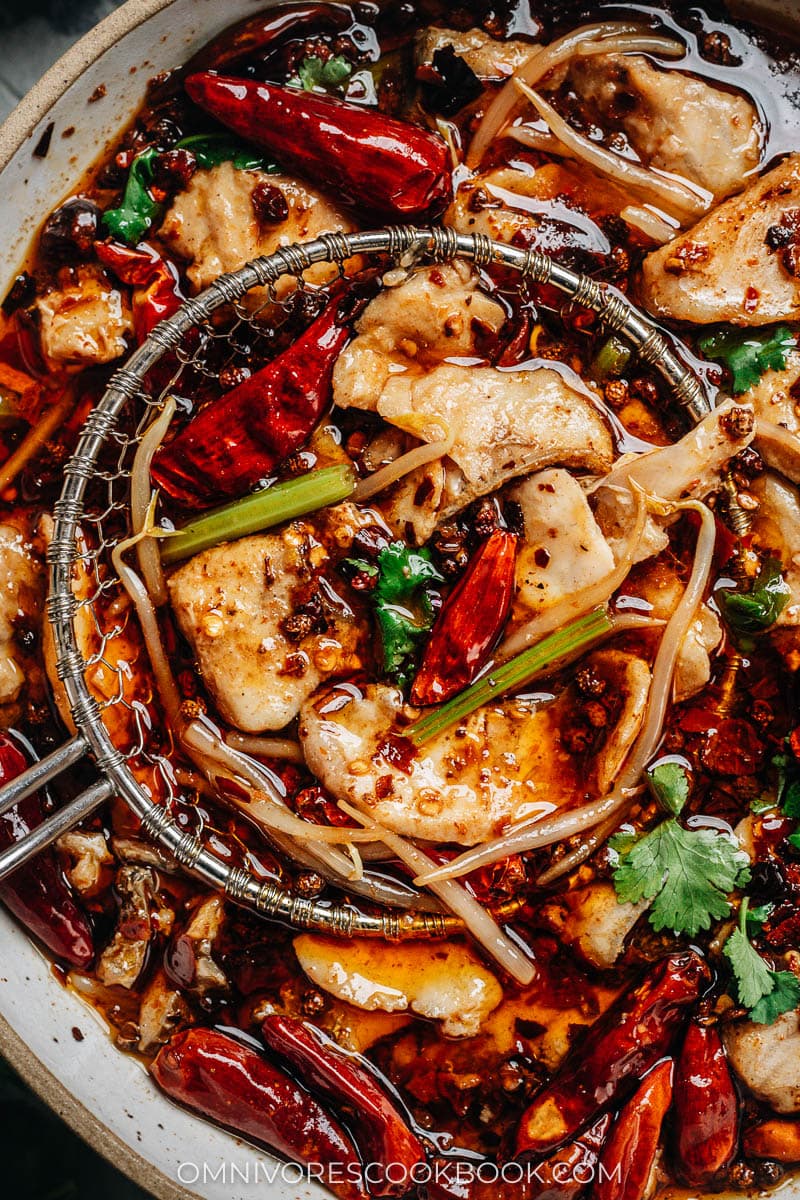
Final thoughts
Shui Zhu Yu is not an easy dish to make. But in my opinion it’s worth every effort because it’s so much cheaper than ordering it in a restaurant. And Chances are, this homemade version will taste better. No matter you’re celebrating Chinese New Year or hosting a dinner party, this dish can be the centerpiece of your table.
In the past, I’ve shared a Shui Zhu Rou recipe (Sichuan Boiled Beef), which is a bit less popular than the fish version but quite delicious as well. The method in that recipe is a lot easier, if you’re looking for a shortcut.
On the other hand, use this recipe if you want the full-on Sichuan experience and when you have a bit of extra time on hand.
Chinese Cooking Made Easy
Are you new to this website? This free email series is a great place to start. I’ll walk you through a few of my most popular recipes and show you how and why they work. You’ll quickly start to cook better Chinese food in your own kitchen.
Watch video

Shui Zhu Yu (Sichuan Boiled Fish, 水煮鱼)
Ingredients
- 1 whole fish (a 2 to 3 lbs / 1 to 1.3 kg fish) , or 2 white fish fillets (branzino, sea bass, snapper, or catfish)
Marinade
- 1 tablespoon Shaoxing wine (or dry sherry)
- 1 teaspoon salt
- 1 teaspoon white pepper
- 1 egg white
- 2 teaspoons cornstarch
Topping
- 1/2 cup Chinese dried chili peppers and extra for garnish
- 2 tablespoons Sichuan peppercorns , a combo of red and green if possible (*Footnote 1)
- 1/3 canola oil , separated (or other neutral oil)
Soup base
- 4 cloves garlic , smashed
- 1 " ginger , sliced
- 3 green onions , cut into 1" (2.5 cm) pieces
- 5 Chinese dried chili peppers , sliced
- 3 tablespoons Doubanjiang
- 1 tablespoon Shaoxing wine (or dry sherry)
- 1 tablespoon sugar
- 1 teaspoon soy sauce
- 1/2 teaspoon mushroom powder (or chicken powder) (optional)
- 1/4 teaspoon white pepper
Vegetables
- 2 cups bean sprouts
- 1 cup chopped Chinese celery (or regular celery) (cut into 1" / 2.5 cm sticks)
Slurry
- 1/2 teaspoon cornstarch
- 1 teaspoon water
Instructions
Butcher the fish (Optional)
- Check to see if there are any residual fish scales. If yes, run your knife gently from the tail to the head to remove the scales.
- Starting at the top of the head, slice along the collarbone.
- Using mainly the tip of your knife, run the blade along one side of the spine to make a 1/2” (1 cm) shallow cut through the skin.
- Make a small slice near the tail, which will be the base of the fillet.
- In smooth motions, use your knife gently to slice the flesh while pressing against the bone and the other hand holding the flesh. Slice the flesh away from the spine until it reaches the rib cage.
- Carefully angle the blade of the knife downward so that you can carve around the bone. It’s OK if some of the bones are attached with the fillet, which you can remove later.
- Once the flesh is released from the rib cage, keep slicing it until the fillet is fully detached from the bone.
- Flip the fish over and repeat on the other side, this time from the tail, until you get two pieces of fish fillets.
- Trim the thin white belly from both sides and discard the pieces (depending on the type of the fish they might taste quite oily, but you can reserve them as well).
- Using a heavy knife or a cleaver, remove the head and tail by pressing the knife against the bone and use one strong motion to cut through it. Chop the spine into 4 pieces.
Prepare the fish fillets
- Starting at the bottom of the fillet, tilt your knife to 45° and slice the fish into 1/4″ (1/2 cm) thick pieces.
- Add the cut fillets, bones, and head (if using) to a medium-sized bowl. Keep the bones and the head on one side of the bowl. Add the marinade ingredients. Gently use your hand to mix the sliced fish until the ingredients are evenly coated. Then gently rub the rest of the seasonings onto the bones and fish head. Be careful not to poke your finger on the fish bones. Set aside to marinate for 15 minutes.
Prepare the topping spices
- Cut the dried chili peppers in half.
- Heat a medium-sized pot over medium-low heat with 2 tablespoons oil. Add the dried chilis, and Sichuan peppercorns. Cook and stir until fragrant but not browned, about 2 minutes. Transfer the spices to a plate to cool slightly, reserving the oil in the pan.
- Add the fried spices into a small food processor or blender. Pulse until coarsely chopped. Set aside.
Prepare the soup base
- Reheat the same pot over medium heat and add the garlic, ginger, green onion whites, and dried chilis. Cook and stir until fragrant, 1 minute or so.
- Add the doubanjiang. Stir for another 2 to 3 minutes. Turn to low heat if the paste starts to stick to the pan too much. You can also pour a bit of water into the pan to release the paste.
- Pour in the Shaoxing wine and use a spatula to lift as much of the brown bits from the bottom as possible.
- Add 5 cups of water and keep scraping the bottom.
- Add the sugar, soy sauce, white pepper, and mushroom/chicken powder (if using). Cook over medium-high heat until bringing to a boil. Reduce to a simmer and cook for another 5 minutes. Use a mesh strainer to remove the solid spices and discard them.
Finish up
- Prepare a large heat-proof bowl, large enough to hold all the broth, the vegetables, and the fish.
- Add the vegetables to the broth and blanch for 1 minute. Remove them from the broth and place them on the bottom of the big bowl.
- Bring the broth back to a simmer. Add the fish bones and head. Cook for 2 minutes, or until the fish head is cooked through. Add the fish bones to the big bowl. (You can add the fish head as well if the bowl is big enough and if you plan to serve the fish head).
- Bring the broth back to a simmer. Add the fillet slices using your hand, a few pieces at a time, and separate them during the process. Poach for 30 second to a minute, or until the fish is just cooked through. Transfer the fish into the big serving bowl.
- Bring the broth to a boil again. Stir to fully dissolve the cornstarch slurry and pour it into the broth, stirring constantly. Cook for 1 minute. Then pour the broth into the serving bowl, until the fish slices are mostly covered. Set aside the remaining broth if there is any left. (*Footnote 2)
- Spread the prepared topping spices over the broth. You can add a few pieces of dried chili peppers for garnish (optional, and they won’t add too much heat).
- Heat the remaining 1/4 cup oil over medium heat in a small pot or saucepan until just smoking. Carefully drizzle the spices over the serving dish. The oil will spatter a bit but shouldn’t cause a mess.
- Serve immediately as a main dish with steamed rice.
Notes
- I used 1 tablespoon of red Sichuan peppercorns and 1 tablespoons of green Sichuan peppercorns. If you do not have the green ones, it’s totally fine to use just the red. If you happen to have green Sichuan pepper oil, skip the green peppers and drizzle 1 teaspoon oil at the end.
- The leftover broth is essentially a fancy mapo tofu sauce. You can use it to cook meat, tofu and vegetables by boiling them in the broth, then using a cornstarch slurry to thicken the sauce.
Nutrition

Did you make this recipe?
I’d love to hear how it turned out for you! Please take a moment to leave a 5-star rating ⭐️ and share your thoughts in the comments further down the page. It really helps others discover the recipe too.
Lilja Walter is a part of the Omnivore’s Cookbook team and worked closely with Maggie to develop and test this recipe.

Adam Bresnick
This is a killer recipe for a genuinely great Sichuan dish. Maggie, you have done a great job making the steps clear, and the dish came together beautifully. We used doubanjiang and red and green peppercorns from the Mala Market. Thanks so much for this brilliant recipe!
Maggie Zhu
So happy to hear you enjoyed the dish! It’s one of my favorite 🙂 Thanks for leaving a positive review.
Gavin in Las Vegas
This is my favorite Chinese dish of all time. It seems so complicated when it arrives on the table in a restaurant but you’ve demystified it for me finally!! I have all of these ingredients on hand anyway, as I love Chinese cuisine. Thanks so much!!
Waldo
This recipe is gold! Made some tweaks but although it’s more then an hour ago I ate it I still feel the heat and the exceptional taste. One of the best sichuan dishes I ever enjoyed, thanks!
Martha
This is my absolute favorite way to prepare fish.This recipe really nailed it for me, I was inspired to buy green peppercorns; Mala Maket is a great find, for introducing us. I confess, just used the black cod fillets that were lingering in my freezer.
James Bridgestone
Thanks for the tips. I loved this recipe very much. Generally, fish is my favorite dish. Although sometimes I feel I would rather add some creative touch to it. Will try your recipe.
Duck Doe
Thank you, Maggie!
I like to eat some fish every week and have been looking for a good recipe. I might well try this one.
Jesse A Rabinowitz
I’ve been hungering for some boiled fish, which I usually get from Cheng Du, our local Sichuan restaurant in Richmond, VA, but decided to use what was at hand. We had frozen Swai, which I defrosted and dried really well before velveting. We had no bean sprouts or Chinese celery, so we used a can of bamboo shoot strips and slices of tree ear mushrooms. The broth was amazing and suffused the shoots and mushrooms richly. It was as good a version of this as any I’ve had in a restaurant. Thanks for this great recipe, Maggie!
Maggie Zhu
So happy to hear you enjoyed the dish! Bamboo shoots and mushrooms sounds super delicious and I would love to add them to my boiled fish next time 🙂
Thanks for leaving a positive review.
Anand Vora
Made it tonight… used a lot more of the bean paste to spice up the dish. This recipe is spot on!
Peggy
Just delicious and beautiful and Sooo tasty. Used 2 Tbl of red pepper paste. Spicey enough.
Garnished with chopped scallion greens. I used bronzini fillets. Perfect fish for this dish.
Neha
I love this dish.. thanks for the recipe. The left over broth.. can I freeze it?
Maggie Zhu
Yes you totally can and use it again! Glad to hear you like the dish 🙂
Jess L
I was so excited to try making this dish that i loved on previous visits to China. I read and followed the recipe at the end of the blog post, and found it so inedibly spicy and painful to eat (though a good flavor). Looking back now, i see you make notes about not eating the broth as part of the larger main description of the recipe, and as a note in the comments. AHHH!!! I feel this should have been a note in the actual typed up recipe as not everyone reads super long blog posts. I know this is user error and i should have realized but maybe to avoid someone making my same mistake just add one more note in the section on how to serve about not including the broth in your bowl of rice. I will try again once i’ve recovered from the spice overload 😀
EVOO
Jess, I also ate the broth and peppercorns! I remember trying this dish once and liking it even with the bites of peppercorns. I liked the spice of the broth but actually found the taste of the peppercorns to be too much. They tasted “perfume-y”. Maybe Sichuan peppercorns just aren’t for me. My husband said he got used to the taste as he continued to eat it. It’s also possible I made some sort of error not frying them long enough. So anyway, love the broth/veggies/fish but wish I had used less Sichuan peppercorns.
Janell D
Thank you! Thank you! I was treated to this experience in China while traveling on business and it blew my mind and since I came home have been trying to figure out how to find a recipe and recreate what I experienced. I made a semi-successful version based on a patchwork search of what I could find but this is so much more complete! I cannot wait to retry with your method. I’m such a fan of your recipes, they’re so good, and I’m so grateful for this one!
CurryCook
Excellent recipe! Maggie, what doubanjiang did you use? The Mala Market 3 year? My broth came out more brown than red and I think it was the doubanjiang. Some notes…. I added napa cabbage and some sliced shiitake, which was good. Fresh cod worked fine for me and didn’t fall apart. Grinding the spices is delicious, but makes it impossible to pick them out (which is good if you have people with different levels of spice tolerance).
Maggie Zhu
I used The Mala Market red oil doubanjiang, which has a bit chili oil in it, which helps with the color. But yeah, the broth itself should be kinda brown.
Good to know the cod worked! It is such a delicate fish so I was very worried it’s gonna fall apart. I guess it works as long as it’s fresh.
I hear you on the ground spice. If you want to pick them out, you need to cut up the peppers instead of grounding them. You also need to use way more because it releases less taste than the grounded.
Anyhow, thanks so much for your feedback and the positive review 🙂
Cynthia
This dish looks delicious! So, you don’t consume the broth? The broth is for cooking and presentation (and to keep warm) only? Looking forward to trying this.
Maggie Zhu
Yeah the broth is for seasoning (quite spicy and salty) so you can’t really serve it. Although you can save it and use it again. You can boil anything in it and it will be very tasty.
In China many people usually take the leftover broth to go so they can make the fish again at home 🙂
RLD
Such a delicious, warming recipe for a snowy day! I couldn’t find Sichuan peppercorns so just used my all time favorite chili crisp from https://www.mr-bing.com as the topping 😉 Super delicious!